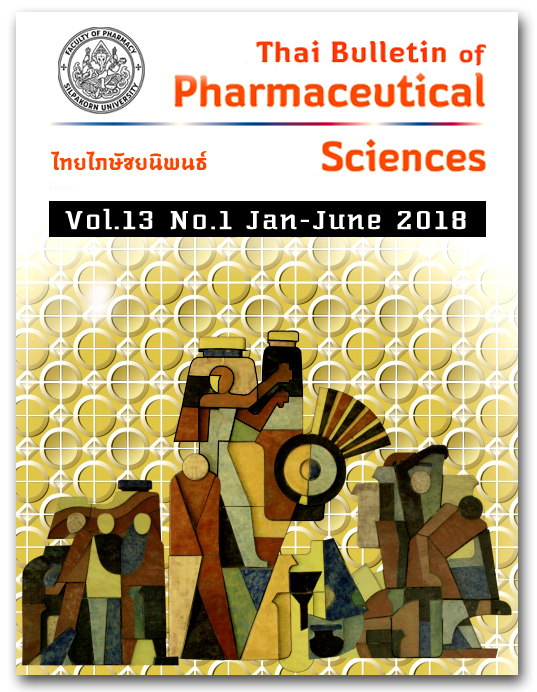IN VITRO BIOLOGICAL ACTIVITIES OF Lonicera japonica FLOWERING BUD COMPARED TO CHLOROGENIC ACID, ROSMARINIC ACID AND CAFFEIC ACID
DOI:
https://doi.org/10.69598/tbps.13.1.27-34Keywords:
Lonicera japonica, flowering bud, chlorogenic acid, rosmarinic acid, caffeic acid, cytotoxicity, antimicrobialAbstract
Lonicera japonica Thub. or Japanese honeysuckle has been widely used in traditional medicine to treat many ailments. Chlorogenic acid, rosmaric acid and caffeic acid are hydroxycinnamic acid derivatives found in this plant part. This study investigated in vitro cytotoxic and antimicrobial of L. japonica flowering bud as well as chlorogenic acid, rosmarinic acid and caffeic acid. Dried L. japonica flowering bud was exhaustively extracted with 95% ethanol. Cytotoxic activities were performed by brine shrimp lethality assay, MTT cell viability assay (5 cancer and 1 normal cell lines) and comet assay. Antibacterial activities against 11 bacterial strains were determined. L. japonica flowering bud ethanolic extract showed non-toxicity on brine shrimp nauplii and 6 tested cell lines. Chlorogenic acid, rosmarinic acid and caffeic acid demonstrated toxicity against brine shrimp nauplii. They showed more cytotoxic potentials against tested cell lines than the extract but were still accepted as no cytotoxicity. The extract and 3 compounds showed human lymphocyte DNA damage by comet assay. They showed no inhibitory activities against tested microorganisms.
References
2. Chaowuttikul C, Palanuvej C, Ruangrungsi N. Pharmacognostic specification, chlorogenic acid content, and In vitro antioxidant activities of Lonicera japonica flowering bud. Pharmacognosy Res. 2017;9(2):128-32.
3. Taofiq O, González-Paramás A, Barreiro M, Ferreira I. Hydroxycinnamic acids and their derivatives: cosmeceutical significance, challenges and future perspectives, a review. Molecules. 2017;22(2):281.
4. Chaowuttikul C, Palanuvej C, Ruangrungsi N. Chlorogenic, rosmarinic and caffeic acids contents in selected Thai medicinal plants by HPLC-DAD. Manuscript in preparation. 2017.
5. Sowemimo A, Venables L, Odedeji M, Koekemoer T, van de Venter M, Hongbing L. Antiproliferative mechanism of the methanolic extract of Enterolobium cyclocarpum (Jacq.) Griseb. (Fabaceae). J Ethnopharmacol. 2015;159:257-61.
6. Cinkilic N, Cetintas SK, Zorlu T, Vatan O, Yilmaz D, Cavas T, et al. Radioprotection by two phenolic compounds: Chlorogenic and quinic acid, on X-ray induced DNA damage in human blood lymphocytes in vitro. Food Chem Toxicol. 2013;53:359-63.
7. Chansukh K, Charoensup R, Palanuvej C, Ruangrungsi N. Antimicrobial activities of selected thai medicinal plants bearing quinonoids. Res J Pharm Biol Chem Sci. 2014;5(2):425-32.
8. Meyer BN, Ferrigni NR, Putnam JE, Jacobsen LB, Nichols DE, McLaughlin JL. Brine shrimp: a convenient general bioassay for active plant constituents. Planta Med. 1982;45(05):31-4.
9. Wang L-N, Wang W, Hattori M, Daneshtalab M, Ma C-M. Synthesis, Anti-HCV, antioxidant and reduction of intracellular reactive oxygen species generation of a chlorogenic acid analogue with an amide bond replacing the ester bond. Molecules. 2016;21(6):737.
10. Li Y, Huang W, Huang S, Du J, Huang C. Screening of anti-cancer agent using zebrafish: Comparison with the MTT assay. Biochem Biophys Res Commun. 2012;422(1):85-90.
11. Park KI, Park H, Nagappan A, Hong GE, Yumnam S, Lee HJ, et al. Polyphenolic compounds from Korean Lonicera japonica Thunb. induces apoptosis via AKT and caspase cascade activation in A549 cells. Oncol Lett. 2017;13(4):2521-30.
12. Magnani C, Chiari BG, Isaac VLB, Correa MA, Salgado HRN. In vitro safety evaluation of caffeic acid. Athens Journal of Health. 2014;1(3):181-8.
13. Burgos-Morón E, Calderón-Montaño JM, Orta ML, Pastor N, Pérez-Guerrero C, Austin C, et al. The coffee constituent chlorogenic acid induces cellular DNA damage and formation of topoisomerase I– and II–DNA complexes in cells. J Agric Food Chem. 2012;60(30):7384-91.
14. Devipriya N, Sudheer AR, Menon VP. Caffeic acid protects human peripheral blood lymphocytes against gamma radiation-induced cellular damage. J Biochem Mol Toxicol. 2008;22(3):175-86.
15. Lou Z, Wang H, Zhu S, Ma C, Wang Z. Antibacterial activity and mechanism of action of chlorogenic acid. J Food Sci. 2011;76(6):M398-M403.
16. Fu L, Li Z, Xie Z, Tan Z, Zhang Q. The in vitro antibacterial activity of dried flowers used in Guangdong traditional soup. Int J Food Nutr Saf. 2015;6:106-16.
Downloads
Published
How to Cite
Issue
Section
License
All articles published and information contained in this journal such as text, graphics, logos and images is copyrighted by and proprietary to the Thai Bulletin of Pharmaceutical Sciences, and may not be reproduced in whole or in part by persons, organizations, or corporations other than the Thai Bulletin of Pharmaceutical Sciences and the authors without prior written permission.



